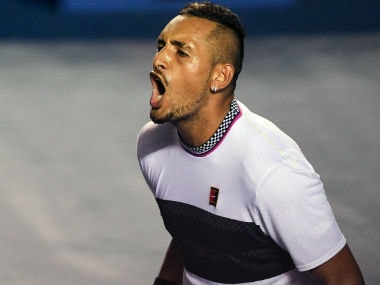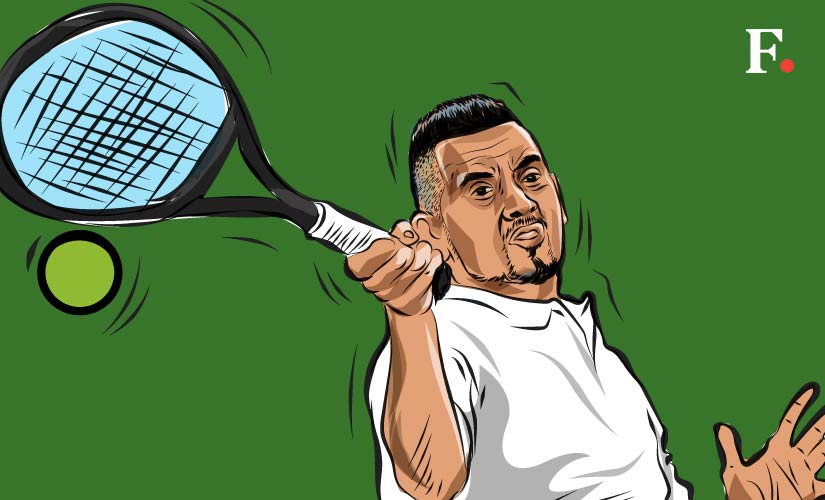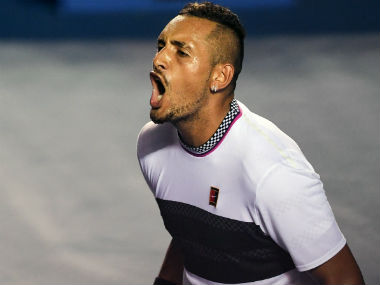At the Queen’s Club Championships, Australia’s Nick Kyrgios was a picture of the diabolical undertones in all of us, which seldom rise to the surface, for most of us have learnt to rein them in, owing to well-established notions of civility. These are times when we feel like there’s very little that’s going our way, that the world has faulted us and those around are having a laugh over our depredations. [caption id=“attachment_6176921” align=“alignleft” width=“380”]  File image of Nick Kyrgios. AFP[/caption] In Kyrgios’ second round against Felix Auger Aliassime, the linesman erred in his judgement, the decision going against Kyrgios. Worse still, there was no review facility which could rectify the mistake. The notion of having been wronged by others flared up, the violent impulse kicked in. Kyrgios launched a ball into the orbit, hurled the second at the advertising board behind him. He cursed his way to the chair at change of ends. While some in the crowd were amused by his outburst, others gawked in disbelief. Admittedly, not the worst of transgressions for Kyrgios. It was a crucial juncture of the match. Kyrgios had won the first set, 7-6. The second set was advancing on serve, with Felix serving at 3-3. A break of serve would have given a serious advantage to Kyrgios who’s known for pounding lethal first serves, plus the deft stroke-play which supplements his surprise, cheeky underarm serve. It wasn’t to be though. The fact that the line judge should make a wrong call when Kyrgios was on the verge of victory must have seemed like a cruel joke to him. That there was no recourse, no one in the crowd, coach or anyone else (Kyrgios rides solo on tour) who could placate him – Kyrgios deems the idea of on-court coaching ridiculous – meant that he was on the verge of losing his wits and he did just that. He didn’t walk off the court though, which would have seemed an improvement from the Masters event in Rome , if not for the drama which ensued in the remainder of the match. Deep in the third set, Kyrgios stopped trying it seemed. Half-cooked serves and a sudden dip in court coverage could be attributed to ‘tiredness’ – it was Kyrgios’ second match of the day – but for his critics, to accuse Kyrgios of ‘tanking’ seems just. He would go on to the lose the match, a tight affair indeed, 7-6, 6-7, 5-7. While walking to his end after acknowledging his opponent and the chair umpire, he flung his racket outside the boundary of the corner court, where it landed smack in the middle of unsuspecting passers-by.
That he remains oblivious to the people he could be unwillingly injuring while doing so is worrisome. It’s not alright anymore to brush his acts under the garb of being the ‘Bad-Boy’ of tennis, as if every sport has to have one and being so gives him the license to act out. Kyrgios needs to be dealt with for what he truly is: a loose cannon, a man-child who’s been treading on the dangerous. Those signs lay in plain sight all the while even as Kyrgios’ critics were placated by tennis aficionados and experts ruing the loss of a special talent. One can’t disagree that the Australian’s misbehaviour has gotten progressively worse since Shanghai last year where Kyrgios unabashedly ‘tanked’ his first-round match against Bradley Klahn. The chair umpire’s rebukes fell on deaf ears as Kyrgios asked him, “Can you call time so I can finish this match and go home?” When asked if he was affected in any way by the crowd’s reaction to his game, having been roundly jeered for his lack of effort, Kyrgios appeared flummoxed with the question. “I don’t owe anyone anything. I feel like if they knew what they were talking about they’d be on the tennis court and being successful as well. I can’t really understand it at all. They don’t know what I’m going through.” No one knew what Krygios was going through until a month later when Kyrgios admitted in interviews to seeing psychologists and trying to get “on top of his mental health issues.” That served him well, felt most, to come out and tell you’re hurting emotionally took guts. Many were optimistic about him changing his ways and getting serious about getting better. That proved to be a false dawn though. For those empathising with Kyrgios in his rare admission of being vulnerable, his run-ins with match officials and resultant outbursts in the last few months have been nothing short of a rude shock. The combustible Aussie has been blowing his top off at the slightest flare-up. The outburst in Rome – he flung a chair across the court for being given a game penalty after yet another run-in with the linesman – should have worried most about the potential escalation in the nature of his antics and why they can’t be deemed as ‘antics’ anymore. The Rome incident was brushed under the carpet, owing in part, to Roger Federer siding against Kyrgios’ critics, saying that suspending the Australian for hurting a chair would be ridiculous and that fining him for the code of conduct violations was punishment enough.
Post everything that went down in Rome, Kyrgios’ had publicly expressed his disliking of the clay courts which could explain his horrid clay-court season, the frequent flare-ups and the decision of not playing the French Open while having proclaimed himself as “one of the best grass-courters in the world.” There was a reason to hope, again, that Kyrgios would change his ways as the grass-court season tees off, considering that it was at Wimbledon where he had first announced himself, defeating Rafael Nadal to make the quarterfinals in 2014. The 19-year old wildcard from Australia had made heads turn then and justifiably so. Fresh as an apple, there were few things conventional about Kyrgios’ playing style, home-grown and well-rounded, the heavy bottom-hand lending his groundstrokes the extra zing while the serves wowed with their speed and pin-point accuracy – he delivered 37 aces in that quarterfinal against Nadal. That he displayed the requisite temperament to match Nadal stroke by stroke, instead of being swayed by the propensity to shock and awe – as he does so routinely nowadays – had evidenced to most that what they were witnessing was special, heralding the rise of a future star. The first time he broke Nadal’s serve in the third set of that match five years ago had him leaping in the air with jubilation, gesturing to his box, coaches, managers, girlfriend, and the works. Kyrgios cared about his tennis then. Commentators and experts were buoyed by his arrival on the scene. When his antics first began to surface, some celebrated him as the next in line to the Djokovic of yore. [caption id=“attachment_4601381” align=“alignnone” width=“825”]  File image of Nick Kyrgios. Art by Rajan Gaikwad[/caption] There were, to be fair, many likeable things about Kyrgios. In a sport which cherished convention and routine, where the rank holders at the top had been there for over half a decade with none coming close to challenging their authority, Kyrgios’s showmanship made him stand out. Those celebrating him, including this author, appreciated how unlike most, Kyrgios wasn’t blinded by the aura of the luminaries of the sport, treating them solely as competitors on the court who could even be at the receiving end of his jibes off the court. The greats of the game would be subject to the whims and fancies of his show, for he treated the court as his theatre where there could be only one showman. However, while performances have been erratic, Kyrgios’s antics remained amazingly consistent, morphing into verbal outbursts, until they became an excuse for his lack of trying. That those ostensibly harmless verbal outbursts have now assumed a more violent tone should not be treated lightly. If there were any doubts over Kyrgios’ outbursts getting violent to the point where the Australian should be treated as an avoidable risk to the sport, post his exit from the Queen’s Club Championships this year, those doubts lay rested, once and for all. That’s not to say he doesn’t care for his tennis. In fact, make no mistake, he probably still does, enough to call the chair umpire a ‘nutter’ or cry foul after wrong calls by the line judge or treating match officials with a barrage of verbal insults for apparently ‘rigging’ the matches. However, he doesn’t care enough to play three sets with the same intensity or to even finish the match on occasion. There’s rare potential being squandered alright. But that need not blind us to the fact that the sport would be better off without a flight risk like Kyrgios.


)

)
)
)
)
)
)
)
)



